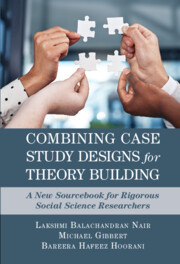 Combining Case Study Designs for Theory Building
Combining Case Study Designs for Theory Building Book contents
- Combining Case Study Designs for Theory Building
- Combining Case Study Designs for Theory Building
- Copyright page
- Contents
- Chapter 1 Introduction to Case Study Research
- Chapter 2 Building Blocks of Case Study Research
- Chapter 3 Of Talking Pigs and Black Swans
- Chapter 4 Do It Again
- Chapter 5 The Natural Experiment, a.k.a. the Single Embedded Design
- Chapter 6 Do It Again (and Again)
- Chapter 7 Sequencing Case Study Designs
- Chapter 8 More on Sequencing Case Study Designs
- Chapter 9 A Parting Note, on an Optimistic Note
- Index
- References
Chapter 7 - Sequencing Case Study Designs
Inductive–Deductive
Published online by Cambridge University Press: 02 February 2023
- Combining Case Study Designs for Theory Building
- Combining Case Study Designs for Theory Building
- Copyright page
- Contents
- Chapter 1 Introduction to Case Study Research
- Chapter 2 Building Blocks of Case Study Research
- Chapter 3 Of Talking Pigs and Black Swans
- Chapter 4 Do It Again
- Chapter 5 The Natural Experiment, a.k.a. the Single Embedded Design
- Chapter 6 Do It Again (and Again)
- Chapter 7 Sequencing Case Study Designs
- Chapter 8 More on Sequencing Case Study Designs
- Chapter 9 A Parting Note, on an Optimistic Note
- Index
- References
Summary
In this chapter, we move on from the archetypical to the sequenced case study designs. First of all, we discuss what sequencing case study designs entail. Using an illustrative example, we discuss one type of sequencing in detail (i.e. the inductive-deductive sequencing). In the context of the example, we discuss the research question, theoretical sampling, controls, cases, embedded units, and the levels of analysis involved in the sequenced design. Lastly, we briefly discuss how to report the sequenced case study design.
Keywords
- Type
- Chapter
- Information
- Combining Case Study Designs for Theory BuildingA New Sourcebook for Rigorous Social Science Researchers, pp. 122 - 143Publisher: Cambridge University PressPrint publication year: 2023


